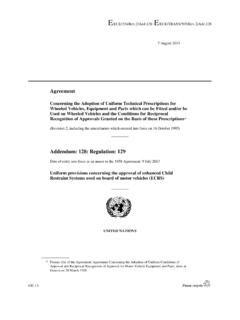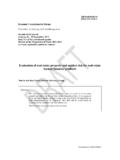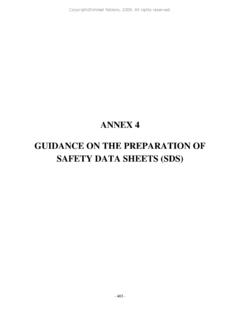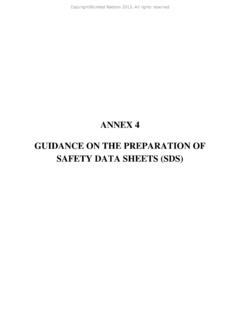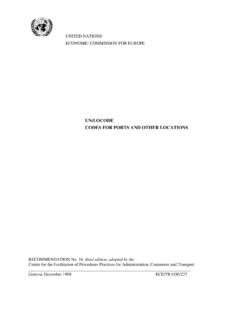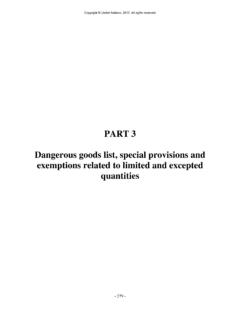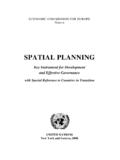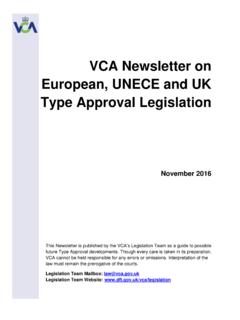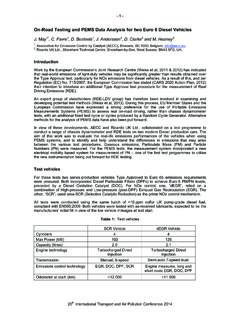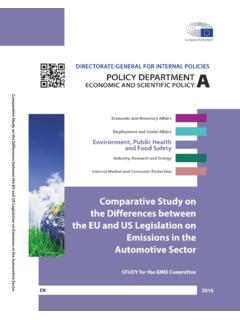Transcription of EU TYPE-APPROVAL PROCEDURE FOR VEHICLES
1 Submitted by the expert of the European Commission Informal document No. IWVTA-02-07 UNECE INFORMAL GROUP ON THE FUTURE DIRECTION FOR HARMONISATION OF vehicle REGULATIONS UNDER THE 1958 AGREEMENT EU TYPE-APPROVAL PROCEDURE FOR VEHICLES Notes: This document provides information about the EU requirements relating to the application for whole vehicle type approval of VEHICLES and complements the other document submitted by the expert of the European Commission relating to the EU WVTA list of requirements. The legal reference for this document is Directive 2007/46/EC of the European Parliament and of the Council establishing a framework for the approval of motor VEHICLES and their trailers, and of systems, components and separate technical units intended for such VEHICLES .
2 The Directive is applicable in the EU Member States since 29 April 2009. The text of Directive 2007/46/EC has been published in the Official Journal of the European Union No L263/1 of and is available in all the official languages of the European Union on the following website: The following consecutive amendments to Directive 2007/46/EC are taken into account as well: 1) Commission Regulation (EC) No 1060/2008 of 7 October 2008 replacing Annexes I, III, IV, VI, VII, XI and XV to Directive 2007/46/EC, 2) Regulation (EC) No 78/2009 of the European Parliament and of the Council of 14 January 2009 on the TYPE-APPROVAL of motor VEHICLES with regard to the protection of pedestrians and other vulnerable road users, amending Directive 2007/46/EC and repealing Directives 2003/102/EC and 2005/66/EC.
3 3) Commission Regulation (EU) No 371/2010 of 16 April 2010 replacing Annexes V, X, XV and XVI to Directive 2007/46/EC of the European Parliament and of the Council establishing a framework for the approval of motor VEHICLES and their trailers, and of systems, components and separate technical units intended for such VEHICLES (Framework Directive). Regulation (EC) No 1060/2008 has entered into force on and is applicable since 29 April 2009. The full text of Regulation (EC) No 1060/2008 has been published in the Official Journal of the European Union No L292/1 of and is available in all the official languages of the European Union on the following website: Regulation (EC) No 78/2009 has entered into force on 24 February 2009 and is save for some provisions - applicable as from 24 November 2009.
4 Specific application dates for vehicle categories can be found in its article 9 which provides a timetable for the application of the requirements. 2 The full text of Regulation (EC) No 78/2009 has been published in the Official Journal of the European Union No L35/1 of and is available in all the official languages of the European Union on the website: Regulation (EU) No 371/2010 is applicable from 29 April 2010. It has been published in the Official Journal of the European Union No L110/1 of 1 May 2010 and is available in all the official languages of the European Union on the website: The provisions relating to the PROCEDURE to be followed for EU whole vehicle type approval can be found in Article 6 of Directive 2007/46/EC as amended, and are reproduced in this document, together with the Annexes I and III to which reference is made in Article 6.
5 It should be noted that Annex IV to which Article 6 also refers is not reproduced in this document, as the text of this Annex IV has already been made available in the other document submitted by expert of the European Commission relating to the EU WVTA list of technical requirements. For the sake of simplicity Annex XI to which reference is made in Article 6 is not reproduced in this document, since it contains provisions for special purpose VEHICLES , which for the time being may not be of relevance for the purpose of establishing the IWVTA roadmap.
6 Finally this document reproduces also the text of Annex V of Directive 2007/46/EC, as it specifies the procedures to be followed during EC TYPE-APPROVAL of VEHICLES , which may be worthwhile considering for the establishment of the IWVTA PROCEDURE . 3 Article 6 procedures to be followed for the EC TYPE-APPROVAL of VEHICLES 1. The manufacturer may choose one of the following procedures : (a) step-by-step TYPE-APPROVAL ; (b) single-step TYPE-APPROVAL ; (c) mixed TYPE-APPROVAL . 2. An application for step-by-step TYPE-APPROVAL shall consist of the information folder containing the information required under Annex III and shall be accompanied by the complete set of TYPE-APPROVAL certificates required pursuant to each of the applicable regulatory acts listed in Annex IV or Annex XI.
7 In the case of the TYPE-APPROVAL of a system or separate technical unit, pursuant to the applicable regulatory acts, the approval authority shall have access to the related information package until such time as the approval is either issued or refused. 3. An application for single-step TYPE-APPROVAL shall consist of the information folder containing the relevant information required under Annex I, in relation to the regulatory acts specified in Annex IV or Annex XI and, where applicable, in Part II of Annex III.
8 4. In the case of a mixed TYPE-APPROVAL PROCEDURE , the approval authority may exempt a manufacturer from the obligation to produce one or more EC system TYPE-APPROVAL certificates, provided that the information folder is supplemented by the particulars, specified in Annex I, required for the approval of those systems during the vehicle approval phase, in which case each of the EC TYPE-APPROVAL certificates thus waived shall be replaced by a test report. 5. Without prejudice to paragraphs 2, 3 and 4, the following information shall be supplied for the purposes of multi-stage TYPE-APPROVAL : (a) at the first stage, those parts of the information folder and the EC TYPE-APPROVAL certificates required for a complete vehicle which are relevant to the state of completion of the base vehicle .
9 (b) at the second and subsequent stages, those parts of the information folder and the EC TYPE-APPROVAL certificates which are relevant to the current stage of construction, together with a copy of the EC TYPE-APPROVAL certificate for the vehicle issued at the preceding stage of construction; in addition, the manufacturer shall supply full details of any changes or additions that he has made to the vehicle . The information specified in points (a) and (b) may be supplied in accordance with the mixed TYPE-APPROVAL PROCEDURE set out in paragraph 4.
10 6. The manufacturer shall submit the application to the approval authority. Only one application may be submitted in respect of a particular type of vehicle and it may be submitted in only one Member State. A separate application shall be submitted for each type to be approved. 4 7. The approval authority may, by reasoned request, call upon the manufacturer to supply any additional information needed to enable a decision to be taken on what tests are required or to facilitate the execution of those tests.
